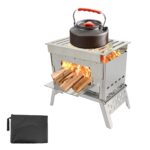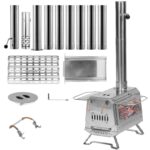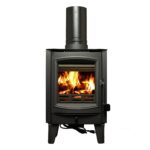
Introduction to Mini Wood Burning Stoves
Mini wood burning stoves represent a compact and efficient alternative to traditional heating methods. These stoves are designed to provide warmth and coziness in smaller spaces, making them an ideal choice for cabins, tiny homes, and even outdoor settings. Unlike conventional wood burning stoves, which can be bulky and require significant installation areas, mini versions are lightweight and portable, allowing users to enjoy the benefits of wood heating without the overwhelming size and weight.
The primary function of a mini wood burning stove is to generate heat by burning small logs or wood pellets. This process not only provides an efficient source of heat but also creates a pleasant ambiance with the sight and sound of a crackling fire. Their design often includes advanced combustion technology, which enhances fuel efficiency and reduces emissions when compared to larger units. This makes mini stoves not just an eco-friendly option, but also a cost-effective solution for heating.
Another distinguishing feature of mini wood burning stoves is their versatility. They can be utilized in various settings, from residential to recreational. Many outdoor enthusiasts favor these stoves for camping or as part of their outdoor living spaces, where they can be easily transported and set up. Additionally, due to their compact nature, they are often compatible with various types of flues, offering flexibility in installation. Overall, mini wood burning stoves blend functionality and aesthetic appeal, contributing to their growing popularity in diverse environments.
As we delve further into this guide, it is essential to explore the specific benefits, designs, and practical applications of mini wood burning stoves, which have gained recognition as an innovative solution for efficient and sustainable heating.
Benefits of Using a Mini Wood Burning Stove
Mini wood burning stoves provide numerous advantages that make them an attractive heating solution for many households. One of the most significant benefits is their efficiency in heating small spaces. Unlike traditional heating systems that require extensive ductwork or large units, mini wood burning stoves are designed specifically to generate heat quickly and effectively in compact areas. Their concentrated heat output ensures that rooms are warmed efficiently, often in a fraction of the time taken by electric or gas systems.
Additionally, mini wood burning stoves are known for their eco-friendliness, primarily due to their use of renewable resources. Wood is a sustainable source of energy when sourced responsibly, and it produces significantly lower levels of carbon emissions compared to fossil fuels. By utilizing wood as a fuel source, homeowners can contribute to reduced dependence on non-renewable energy and promote a cleaner environment. Moreover, many modern mini wood burning stoves are engineered to minimize smoke output, further enhancing their environmental advantages.
Cost-effectiveness is another compelling reason to consider mini wood burning stoves. The rising prices of electric and gas heating solutions can lead to substantial utility bills, particularly during the winter months. In contrast, wood remains a relatively affordable fuel source, especially for those who have access to their own wood supply. When calculating long-term heating costs, many users find that mini wood burning stoves can significantly lower their overall expenses. Given the combination of efficiency, eco-friendliness, and cost-effectiveness, mini wood burning stoves represent a practical option for heating small living spaces sustainably.
How to Choose the Right Mini Wood Burning Stove
When selecting a mini wood burning stove, several key factors should be considered to ensure that it meets your specific needs. Understanding these elements will help consumers make informed decisions and maximize the benefits of their purchase.
First and foremost, size plays a crucial role in the selection process. Mini wood burning stoves are available in various dimensions to suit different spaces. Consider the area where the stove will be placed; it should fit comfortably without overcrowding the room. Additionally, it’s important to assess the heating capacity of the stove. Based on the size of the space, a stove with the appropriate heating output will ensure efficient warmth without wasting fuel.
Material is another critical consideration when choosing a mini wood burning stove. Stoves are typically made from cast iron, steel, or other durable materials. Cast iron stoves are known for their excellent heat retention, while steel stoves tend to heat up quickly. Depending on your preference for heat regulation and aesthetic appeal, you may choose accordingly.
Design is also significant; some may prefer a traditional look, while others might lean towards modern aesthetics. Selecting a design that complements your existing décor will enhance the overall ambiance of your space. Furthermore, look for features such as glass doors or ash pans, which can add convenience and improve functionality.
In addition to these factors, it is beneficial to review reviews and ratings of various mini wood burning stoves. This can give insight into the performance and satisfaction levels from other users. Ultimately, creating a checklist that outlines your preferences in size, material, design, and heating capacity will guide you towards making a well-informed choice. This careful selection process ensures that you select a mini wood burning stove that not only meets your functional needs but also aligns with your personal style.
Installation Guide for Mini Wood Burning Stoves
Installing a mini wood burning stove requires careful planning and adherence to safety regulations to ensure both efficiency and safety. The first step in the installation process is choosing an appropriate location. This location should be level and capable of supporting the weight of the stove, ideally in a space that maximizes heat distribution throughout the area. Moreover, it is crucial to ensure that the stove is situated at least three feet away from any combustible materials, including furniture, curtains, and walls.
Once the location is identified, one must address the flue system. The flue pipe is essential for proper ventilation, expelling smoke and harmful gases outside. The pipe should be constructed of durable, heat-resistant materials to withstand high temperatures. When installing the flue, it is advisable to minimize the number of bends and angles to facilitate an unobstructed exhaust flow. Vertical runs are favored, as they enhance draft and reduce the likelihood of creosote buildup, which can lead to chimney fires.
Before proceeding with installation, reviewing local building codes and regulations is paramount. Many jurisdictions have specific requirements concerning chimney heights and distances from flammable structures. Additionally, securing necessary permits often ensures compliance with these codes and provides peace of mind.
Proper insulation and sealing around the flue pass-through are also essential. Insulation not only protects the structure from heat but also enhances the stove’s efficiency by maintaining internal temperatures. A fire-resistant material should be used to seal any gaps to prevent draft issues and heat loss.
Lastly, it is crucial to conduct a thorough inspection of the installation once completed. This includes testing the stove for proper operation and ensuring that the flue is free from obstructions. By following these guidelines, users can enjoy the benefits of their mini wood burning stove while ensuring safe and effective heat generation.
Maintenance and Care for Mini Wood Burning Stoves
Proper maintenance and care are essential for ensuring the longevity and efficiency of mini wood burning stoves. Regular upkeep not only enhances performance but also contributes to safety and an enjoyable experience. The following tips outline key practices for maintaining your stove.
Firstly, routine cleaning is vital. Ash deposits can accumulate in the firebox and must be removed regularly to avoid obstructing airflow. Use a suitable ash vacuum or a metal container with a lid for disposal after ensuring that the ashes are completely cool. Cleaning the stovepipe and chimney is also crucial to prevent creosote buildup, which can present significant hazards, including chimney fires. This should be conducted at least once a year, or more frequently if you use your stove regularly.
Inspection plays a critical role in maintaining your mini wood burning stove. Regularly check for signs of wear and tear, such as cracks in the body or hearth and any deterioration in the door seals. Ensuring that the door closes tightly prevents smoke from escaping and improves combustion efficiency. Furthermore, inspect gaskets and replace them if they show signs of damage, as this will further optimize performance and safety.
Implementing preventative measures can greatly extend the life of your mini wood burning stove. One effective strategy is to use quality seasoned wood, as it produces less smoke and reduces soot buildup. Avoid burning wet or treated wood, which can negatively affect both the stove’s efficiency and the air quality in your home. Additionally, maintaining a clean surrounding area will help prevent unwanted debris from entering the stove, which could hinder its operation.
In conclusion, regular maintenance and care are paramount for the optimal functioning of mini wood burning stoves. By adhering to these cleaning and inspection practices, and by taking steps to prevent potential issues, you can enjoy a safe, efficient, and long-lasting heating source in your home.
Safety Tips When Using Mini Wood Burning Stoves
Operating mini wood burning stoves can be an efficient and enjoyable way to heat a space. However, safety should be a top priority to prevent potential accidents or health risks associated with their use. One of the primary concerns when using wood burning stoves is carbon monoxide (CO) exposure. This odorless gas is produced during the combustion of wood and can pose serious health risks, including headaches, dizziness, and in extreme cases, death. Therefore, it is essential to ensure that your mini wood burning stove is properly ventilated to allow for the safe dispersion of combustion gases.
Using the correct type of fuel is also crucial for safe operation. Only dry, seasoned wood should be utilized in your stove, as burning wet or unseasoned wood can create excess smoke and increase the risk of hazardous emissions. It is advisable to avoid using treated wood, plastic, or other materials that may release toxic fumes when burned. The use of proper fuels not only promotes safety but also ensures that the stove operates efficiently.
Another important safety measure is the installation of smoke detectors in areas where mini wood burning stoves are in use. Smoke detectors can alert occupants to any smoke or fire hazards arising from the stove, allowing for prompt action to mitigate danger. Regular maintenance of both the stove and the chimney is also essential to prevent creosote buildup, which can cause dangerous chimney fires. It is recommended to have the chimney cleaned annually by a professional to ensure it operates safely.
By adhering to these safety tips, users can enjoy the benefits of a mini wood burning stove while minimizing risks associated with its operation. Ultimately, understanding and implementing these guidelines will foster a safer heating experience in your home.
Popular Brands and Models of Mini Wood Burning Stoves
When considering mini wood burning stoves, several brands stand out for their exceptional quality and performance. Among them, the primary contenders include companies such as Camp Chef, EcoZoom, and Solo Stove. Each brand offers unique features designed to cater to different camping and home heating needs.
Camp Chef is renowned for its versatile outdoor cooking equipment, including compact wood burning stoves. Models like the Camp Chef Alpine are appreciated for their efficient burning system and portability, with prices ranging from $120 to $200. These stoves are designed for cooking and heating, making them ideal for camping trips where utility is key.
EcoZoom has gained a reputation for its eco-friendly approach to outdoor cooking. The EcoZoom Versa, priced around $130, features a rocket stove design, ensuring minimal wood consumption and maximum heat output. Customers frequently commend its durability and ease of use, which enhances the outdoor experience without contributing significantly to environmental degradation.
For enthusiasts looking for a more modern design, Solo Stove’s Lite model is a top choice. With a price point of approximately $70, this stove is designed for optimal airflow, resulting in a highly efficient wood burn. The compact structure makes it extremely lightweight, perfect for backpacking and long hikes. Reviews often highlight its ease of setup and effective smoke reduction, making it a favorite among campers.
When evaluating mini wood burning stoves, it is crucial to consider customer feedback and performance features. Prices can vary, but investing in a reputable brand ensures reliability and efficiency in use. Each of these brands offers well-crafted products praised for both their functionality and user-friendly designs, aiding potential buyers in making informed choices.
Alternative Heating Options Compared to Mini Wood Burning Stoves
When considering heating solutions for residential or recreational spaces, mini wood burning stoves are just one of several options available on the market. To help consumers make informed decisions, it is essential to compare these stoves with alternative heating methods such as electric heaters, propane heaters, and larger wood stoves. Each option has distinct advantages and drawbacks that can significantly affect efficiency, cost, and overall user experience.
Electric heaters are a popular choice for their convenience and ease of use. They often have a straightforward setup and require minimal maintenance. However, their operating costs can escalate, particularly in regions with high electricity rates. Efficiency can vary depending on the design of the unit; some portable electric heaters may provide instant warmth but lack the radiant heat that a mini wood burning stove can supply over a longer duration. Additionally, reliance on electricity can pose a challenge during outages.
Propane heaters also offer portability and convenience. They are generally more efficient than electric heaters in terms of heat output per dollar spent. Propane units can deliver immediate warmth and do not require electrical connectivity. However, the costs associated with propane can be a downside, particularly during peak season or in climates where heating needs are prolonged. Storage and safety considerations of propane tanks also necessitate careful handling.
Larger wood stoves may provide a more robust heating solution for larger spaces or long-term use. They often have a higher heat output and can maintain warmth even after the fire has burned down. However, their size and installation requirements could be a significant investment. Further, the maintenance involved in operating larger wood stoves, including regular chimney cleaning and wood procurement, may be more demanding compared to the simpler management of a mini wood burning stove. Each heating option has its place, and understanding their differences can guide users to choose the most suitable choice for their specific needs.
Conclusion: Embracing the Warmth of Mini Wood Burning Stoves
In reviewing the various facets of mini wood burning stoves, it becomes clear that these compact heating solutions offer a wide range of benefits suitable for diverse environments. The efficiency of mini wood burning stoves in heating both indoor and outdoor spaces has made them increasingly popular among homeowners and outdoor enthusiasts alike. Their ability to produce significant warmth while using natural resources underscores their appeal in a time of heightened environmental awareness.
Moreover, the portability of mini wood burning stoves enhances their versatility. Whether one is seeking to enjoy a cozy evening in a garden or embarking on a camping trip, these stoves provide a convenient and effective means to generate heat. Their design, often characterized by innovation and aesthetics, allows them to seamlessly blend into various settings, contributing to both functionality and style.
Additionally, the sustainability aspect cannot be overlooked. Mini wood burning stoves promote the use of renewable resources by utilizing wood, which can be sourced locally. This not only reduces reliance on fossil fuels but also fosters a connection to nature that many find rewarding. In a world increasingly focused on sustainability, opting for a mini wood burning stove represents a commitment to more eco-friendly living.
Ultimately, as you ponder your heating options, consider the multitude of advantages that mini wood burning stoves offer. From their efficiency and portability to their environmental benefits, these stoves stand out as a compelling alternative for those aiming to enhance their heating solutions. Investing in a mini wood burning stove may not only warm your space but also enrich your lifestyle. We encourage you to explore the possibilities they present, bringing warmth and joy into your home or outdoor retreats.





